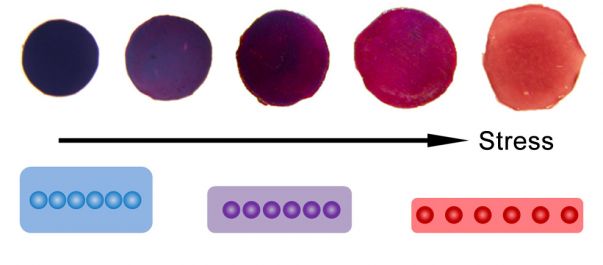High-resolution Pressure Sensor That Displays Varying Colors - Research At UC, Riverside
Researchers from University of California, Riverside have developed a new kind of high-resolution pressure sensor that displays the amount of pressure on a surface with different colors. This means that the sensors are visible to everyone's eyes. The interesting thing about this research work is that, when used in everyday products that we use, we can have really helpful and useful applications. For example, automobile companies can paint their dummy cars with a substance that changes color with respect to varying levels of stress. During the automobile's crash test, the engineers can gather important information about stress endurance for various parts of the vehicle using the color codes or color map. This then can be used to design safer vehicles in the future. Another great example is that of gloves worn by different sportsmen. By checking the colors displayed by the pressure sensor, they can gauge the appropriate amount of pressure they should be applying to grip their bats.
Yadong Yin, an Associate Professor of Chemistry at the UC, Riverside university, led this research work. The team calls it the "colorimetric stress memory sensor". Using a self-assembly, gold nanoparticles were strung together and later embedded into a polymer film. Because the film deformed when pressed, gold nanoparticle strings got stretched by the increase in the distance between adjacent gold nanoparticles. Due to this, the interaction of nanoparticles with light changes. When linked together, the gold nanoparticles originally appear blue. But they gradually change to red with increasing pressure as the nanoparticles start disassembling. Check out the following illustration that shows the change in color of the sensor film after undergoing different amounts of pressure.
 This new high-res pressure sensor is different the the pressure sensor films in use today. They suffer from low resolution and low contrast. They display pressure change by varying intensity of only one color (such as light blue to dark blue). Whereas, the newly designed sensor in Yin's Lab can generate a range of easily distinguishable colors that have both higher contrast and resolution and can work on very complex surfaces too (even if they are not flat or uniform). Yin goes on to share that instead of gold, copper or silver could be used.
This new high-res pressure sensor is different the the pressure sensor films in use today. They suffer from low resolution and low contrast. They display pressure change by varying intensity of only one color (such as light blue to dark blue). Whereas, the newly designed sensor in Yin's Lab can generate a range of easily distinguishable colors that have both higher contrast and resolution and can work on very complex surfaces too (even if they are not flat or uniform). Yin goes on to share that instead of gold, copper or silver could be used.
The researchers further explain that, by reversing the process i.e. disassembly - the sensors will undergo reverse color change: from blue to red. And disassembly can be achieved by a simple mechanical force. To know more about his work, you can check the #-Link-Snipped-# that appear this month in Nano Letters.
What are your thoughts on the new pressure sensors? Share with us in comments.
Source: #-Link-Snipped-#
Yadong Yin, an Associate Professor of Chemistry at the UC, Riverside university, led this research work. The team calls it the "colorimetric stress memory sensor". Using a self-assembly, gold nanoparticles were strung together and later embedded into a polymer film. Because the film deformed when pressed, gold nanoparticle strings got stretched by the increase in the distance between adjacent gold nanoparticles. Due to this, the interaction of nanoparticles with light changes. When linked together, the gold nanoparticles originally appear blue. But they gradually change to red with increasing pressure as the nanoparticles start disassembling. Check out the following illustration that shows the change in color of the sensor film after undergoing different amounts of pressure.

The researchers further explain that, by reversing the process i.e. disassembly - the sensors will undergo reverse color change: from blue to red. And disassembly can be achieved by a simple mechanical force. To know more about his work, you can check the #-Link-Snipped-# that appear this month in Nano Letters.
What are your thoughts on the new pressure sensors? Share with us in comments.
Source: #-Link-Snipped-#
Replies
You are reading an archived discussion.
Related Posts
For those in the state and from the state of Maharashtra .. cheers 😀
Otherwise, we can always celebrate Labor Day !!
A team of researchers led by Bellave Shivaram, a University of Virginia professor of physics, has discovered that a universal law that describes that the metal alloys can undergo dramatic...
Chinese tech-giant - OPPO Electronics Corp. has launched a new smartphone called the 'Oppo R1' in India at a price of Rs. 26,990. Back in January this year, the company...
i got 372 gate score... which colleges will i will get to join for mtech... belongs to general category... pls give suggetions...
CEans,
This is your chance to become a part of the popular VoiCE Team. We have opened applications for the position of VoiCE Contributor.
We expect you to possess exceptional...
